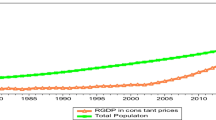Abstract
The universal process of population change has significant attainment of social and economic implications at global level. Demographic transition is not only consisting of population growth tendency but much more along with economic consequences Karnataka is in the third stage of demographic transition and this scenario is marked with opportunities and challenges. This paper examines the demographic trends of Karnataka by using different Census data collected from Census reports and time series data over the time period of 1991–2014 collected from SRS. The fertility and mortality levels in the state have declined considerably. The districts in the Karnataka state have shown considerable increment in HDI from decade to decade. The study used the bound testing approach to co-integration; Autoregressive Distributed Lag (ARDL) model was also applied for analyzing the long run relationship whereas Error Correction Mechanism (ECM) was applied for analyzing the short run link of the demographic variables with economic growth. The study exhibited that the demographic transition positively affected the economic growth in the long run and negatively in the short run.

Source: Census of India (2011)

Source: Sample Registration System Bulletins, Registrar General of India

Source: 2011-Annual Report on Registration of Births and Deaths Act. 1969

Similar content being viewed by others
References
Becker, G.S., E.L. Glaeser, and K.M. Murphy. 1949. Population and economic growth. American Economic Review 89 (2): 145–149.
Bloom, D.E., and J.G. Williamson. 1998. Demographic transition and economic miracles in emerging Asia. World Bank Economic Review 12: 419–55.
Bloom, D.E., D. Canning, and J. Sevilla. 2002. The demographic dividend : A new perspective on economic consequences of population change Santa Monica: RAND. https://www.rand.org/content/dam/rand/pubs/monograph_reports/2007/MR1274.pdf.
Brown, R.L., J. Durbin, and J.M. Evans. 1975. Techniques for testing the constancy of regression relations over time. Journal of the Royal Statistical Society 37: 149–192.
Census of India website. 2011. http://www.censusofindia.com.
Chesnais, C.J. 1992. The demographic transition: Stages, patterns and economic implications. Oxford: Clarendon Press.
Davis, K. 1945. The world demographic transition. Annals of the American Academy of Political and Social Science 237:1–11
Feyrer, J. 2007. Demographics and productivity. The Review of Economics and Statistics 89 (1): 100–109.
Harris, H., and R. Sollis. 2003. Applied time series modelling and forecasting. West Sussex: Wiley.
Karnataka Human development Report. 2005. Investing in human development. Planning and Statistics Department, Government of Karnataka.
Mason, A. 2005. Demographic transition and demographic dividends in developed and developing countries. United nations expert group meeting on social and economic implications of changing population age structure, Mexico. https://www.un.org/esa/population/meetings/EGMPopAge/EGMPopAge_2_AMason.pdf.
Men and Women in Karnataka. 2014. Publication, training and co-ordination Division Directorate of Economics & Statistics, Bangalore.
Notestein, F.W. 1945. Population—the long view. In Food for the world, ed. T.W. Schultz. Chicago: University of Chicago Press.
Pesaran, M.H., Y. Shin, and R.J. Smith. 2001. Bounds testing approaches to the analysis of level relationships. Journal of Applied Econometrics 16: 289–326.
Pesaran, M., and Y. Shin. 1999. An autoregressive lag modeling approach to cointegration analysis. In Econometrics and economic theory in 20th century: The Ragnar Frisch centennial symposium, ed. S. Strom. Cambridge: Cambridge University Press.
SRS. 2009. Sample Registration System Bulletins, Registrar General of India
United Nations. 2010. World population prospects, New York.
Author information
Authors and Affiliations
Corresponding author
Rights and permissions
About this article
Cite this article
Megeri, M.N., Manoj Kumar, G. Demographic Transition and Economic Development in Karnataka. J. Quant. Econ. 16, 173–183 (2018). https://doi.org/10.1007/s40953-016-0068-x
Published:
Issue Date:
DOI: https://doi.org/10.1007/s40953-016-0068-x




